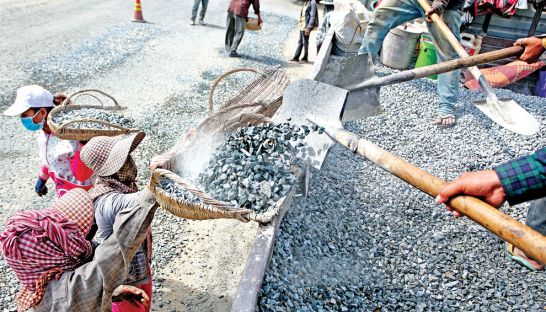Urban poor losing out in growing capital city
Urban poor losing out in growing capital city
A new report by the World Bank says the Cambodian government needs to invest in infrastructure and social protection to make city life in the Kingdom sustainable.

Without better urban planning, the gap between the rich and poor will widen in Cambodia, the World Bank has said.
In a report titled Expanding opportunities for the urban poor, the Bank says there is a need for more infrastructure and social protection, as well as better employment opportunities for those living in cities. Noting that the East Asia Pacific region is undergoing the fastest urbanization in the world (and thus in history), the report says that the current three percent rate of urbanization is creating problems that need urgent solutions.
Noting that the region has the world’s largest slum population of 250 million people, the report says that many of these urban poor live in neighbourhoods with poor sanitation and transport infrastructure. Urban slums are often located in areas prone to flooding or natural disasters, making their populations highly vulnerable.
If countries in the region don’t give their poor city dwellers a better deal, they’ll hamper their economic growth. In some parts of East Asia, people spend more than a third of their monthly income on commuting.
Victoria Kwakwa, the World Bank’s vice president for East Asia and the Pacific, said: “Cities across East Asia have propelled the region’s tremendous growth. Our collective challenge is to expand opportunities to all in the cities, from new migrants living in the peripheries to factory workers struggling to pay rent, so they can benefit more from urbanization and help fuel even stronger growth.”
Cambodia’s rate of urbanization is 2.6 percent, which is very fast but not as fast as the regional rate of three percent. However, the report says that the Kingdom’s urban population density is particularly high. At 8,600 persons per square kilometre, it is more than double that of Laos, where the equivalent figure is 3,600 per square kilometre.
“Rapid urbanization is a challenge and an opportunity,” says the report’s author Judy Baker, who is the World Bank’s lead urban specialist. She lists what needs to be done: “Provide low-income residents with affordable transport services or housing, so they can save for their children’s education. Ensure that social protection programs are in place to help families cope during difficult times, such as in the aftermath of natural disasters.
“Solutions for inclusive urban growth are not one--fits-all, but they are practicable, effective, and necessary for the greater good.”
Six of the world’s ten megacities are in East Asia, but it is in secondary cities that the problem of urban poverty is worst, the report says. Cambodia’s largest urban areas are Phnom Penh, with 1.6 million inhabitants, Siem Reap, with 264,000, and Battambang, with 229,000.
80 percent of the Kingdom’s population lives in the countryside, one of the lowest proportions in the region. However, Cambodia is urbanizing rapidly, making good strategic planning for urban areas vital. The report criticizes this aspect of Cambodia’s development: “Where urbanization has occurred, it has been largely unplanned for and unregulated. As a result, Phnom Penh has seen an increase in traffic congestion, flood risk, and squatter and slum settlements.
“Without urban planning interventions, Cambodia will continue to experience widening spatial and economic disparities within its cities.”
Especially vulnerable in the Kingdom are women. Cambodia’s last census in 2008 found that while a quarter of all the country’s households are headed by women, that figure rises to 38 percent in urban poor communities. The report also cites two recent studies and says that the proportion of people living in poverty in Phnom Penh is almost 30 percent, well above the officially quoted figure of 12.8 percent.
The two studies into the urban poor, completed in 2012 and 2014, also found that:• Nearly one in four households care for vulnerable children (orphans, abandoned, or those with disabilities). A fifth of households have members with chronic illnesses.
• Most of those living in urban poor communities are employed in low-skill occupations, and 60 percent of households earn less than $75 a month.
• More than two-thirds of the urban poor are in debt, with loan payments forming a “significant portion of monthly expenditures.” Most of these payments go towards paying down interest rather than the principle.
The report details the situation in Phnom Penh regarding slums and urban housing. “Since 1980, the Phnom Penh city administration has identified 516 different urban poor communities. Common settlement sites are along major infrastructure and transportation lines in and out of the city, including main roads, railways, and sewage systems.
“These sites are often public lands where households have constructed simple one-room houses. Houses are built on stilts in flood-prone areas.”
While the government has ensured that most residents in the capital have access to roads (96 percent), electricity (92 percent) and water (85 percent), sewage systems and garbage collection are patchier, with 72 percent and 60 percent benefiting from these services, respectively.
The report says: “Furthermore, awareness of sanitation and environmental issues is low among urban poor communities, and contaminated water and environmental hygiene remain concerns within poor neighbourhoods.” It also notes the construction of self-contained “satellite cities” in locations around the capital and says these are exacerbating the divide between rich and poor.
It concludes: “Without pushing for comprehensive city infrastructure, Phnom Penh risks seeing development only for the wealthy. Currently, these satellite cities are not included in any broader development plan and do not coordinate infrastructure with surrounding neighbourhoods.
Some initiatives have been put in place to help Cambodia’s urban poor. The Urban Poverty Development Fund supports thousands of local savings groups and provides low-cost loans to the urban poor, and some investment has gone into infrastructure.













